Arts
From Goddess to Bibi: Power and its portrayal in paintings
The ongoing exhibition at the Siddhartha Art Gallery houses Patachitra, Bilampau, and Kalighat paintings.
Isabel Irwin
Is the portrayal of a woman in a position of power inherently feminist? This question struck me when I visited the Siddhartha Art Gallery's latest exhibition featuring Kalighat paintings.
I found myself amused and conflicted by one piece, ‘Babu and Bibi II,’ in which a bourgeois woman holds a leash attached to a dog with a man's head.
In today's art world, feminism has become a buzzword—from discussions in my homeland of Cyprus to my university classrooms in the US and now here in Kathmandu.
Yet, beyond the surface-level rhetoric of ‘feminism’ and ‘equality’, deeper conversations often reveal these concepts' ambiguity and diverse interpretations. Feminism means something different to everyone, even within the same progressive circles.
Siddhartha Art Gallery’s exhibition places three story-telling art forms in conversation with one another: Patachitra, Bilampau, and Kalighat paintings.
Patachitra is the original art form from which folk artists deviated to invent the Bilampau and Kalighat styles. This is one of the most unique aspects of the exhibition; by placing all three styles alongside one another, visitors can see the evolution of folk art as it travelled across South Asia.
Bilampau paintings result from the Patachitra tradition of crossing from India into Nepal, and Kalighat is the product of the migration of Patachitra artists to Kolkata. All three art styles share certain narrative and symbolic attributes.
When stepping into the gallery, the Kalighat paintings stand out the most as they differ quite from Patachitra and Bilampau in style and subject matter. Unlike the other two painting styles, these paintings depict a scene with only one or two characters and have no background details.
Nepali Bilampau narrative scrolls differ from Patachitra in that they tell a story from left to right rather than vertically. Apart from the direction of the narrative, Bilampau and Patachitra paintings are largely similar in featured stories and style.
Before stepping into the exhibition, I hadn’t encountered Kalighat paintings, but their depiction of women immediately captured my attention. These small-scale artworks defy conventional gender roles, blending humour with a sharp critique of their time's moral and social norms.
What drew my interest was that the artists' intentions are almost completely left to the imagination.
Diving into the context of Kalighat paintings sheds some light on their potentially intended messages and whether they can be dubbed as ‘feminist’ or not. These paintings trace directly back to the goddess Kali, often called the ‘mother Goddess’.
Kali destroys evil to protect the innocent and is associated with power, change, deviance, and time—all traits that result in her depictions being strongly connected to feminism.
The Kalighat art style was born around a temple dedicated to the Goddess Kali, the Kalighat temple, in 19th-century Kolkata (then Calcutta). Folk ‘patua’ artists migrated to the city, near the Kalighat temple, as it became a trade centre in colonial India.
These artists were trained in Patachitra narrative scroll paintings, which were several feet long and contained some narrative scenes.
Once the folk ‘patua’ artists moved to Kolkata, many saw an opportunity in the popularity of the Kalighat temple.
Shifting away from their narrative scrolls, they began to use their artistic skills to produce portable depictions of the Goddess Kali and other deities for people to take home as religious souvenirs. It didn’t take long for these ‘Kalighat paintings’ to grow in popularity, and the art style emerged as a distinct art genre.
These initial versions of Kalighat paintings can also be seen in the Siddhartha Art Gallery’s new exhibition, such as a beautiful piece depicting Krishna playing the flute for Radha and a piece named ‘Kalighat Kali’.
The second phase of these paintings is where the scenes become more interesting and potentially controversial. In the mid-1900s, Kalighat artists moved away from solely religious characters and began using their paintings as an active means of subversion.
Their paintings focused on the pretensions of the ‘Babu culture’—the Westernised, upper-class Bengali men who adopted European mannerisms and fashions.
The influence of British colonialism on gender roles and Babus and Bibis in Bengal cannot be understated.
As Western ideas and practices permeated Bengali society, traditional gender roles were challenged and reinterpreted. Kalighat artists navigated these shifts with astute observation and artistic flair, capturing the tension between tradition and Western modernity concepts.
The Babus and Bibis featured in each painting are distinctive in their dress and jewellery, which are always lavish and influenced by European culture.
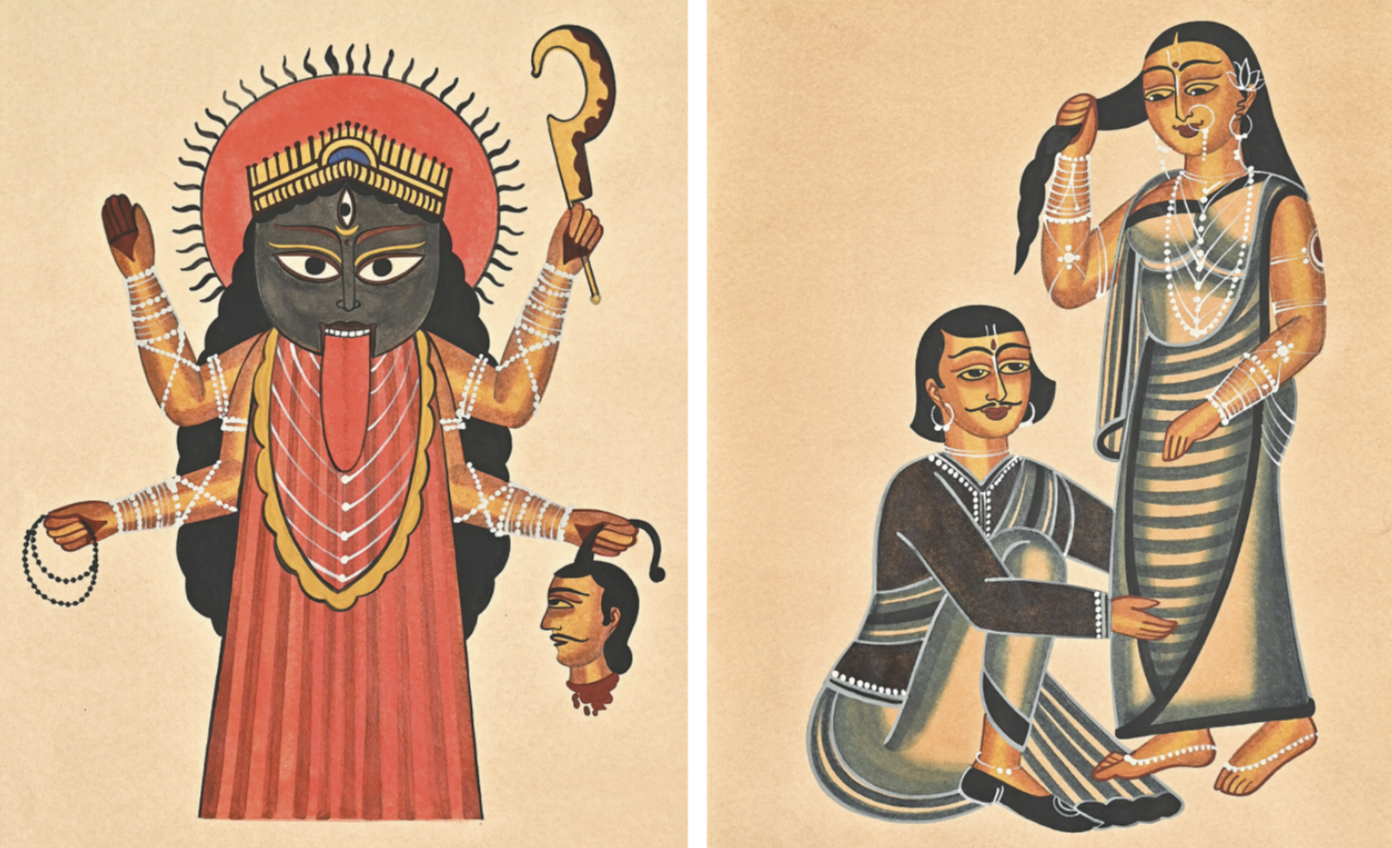
What may be first noticed in Siddhartha’s current collection is that Babus also nearly always have a long, thin moustache, while Bibis are voluptuous and wear relatively revealing clothing.
These caricatures entertained the public and served as cautionary tales, warning against the pitfalls of excess and moral decay caused by opulence.
British colonial officers were also sometimes depicted in humorous anti-colonial scenes. Kalighat artists became widely known for their keen sense of humour and a sharp eye for social satire.
Multiple artists or whole families often made these artworks, each member performing a specific task such as paper preparation, outlining, or shading. Most importantly, the artists never signed their works or gave their works titles, meaning that the exact origins and intended meanings of the depicted scenes are not specified for the viewers.
In other words, each work that a visitor sees in the gallery’s exhibition, or any other collection, has been given a title by the curator rather than the artists behind the work.
Therefore, even though the chosen expressions and positioning in each painting always tell a story, the artist's intended message is left up to interpretation, which can be wildly misleading in many cases.
In some Kalighat artworks featured in the exhibition, we can see where the artist’s intended meaning and the later given title potentially drastically conflict. For example, a painting labelled ‘Bibi with her pets’ features Bibi sitting on a chair with a snake, tiger and bull at her feet.
Since the bull and tiger are depicted drinking from the same dish, this scene could be referencing a Bengali saying, “baghe-gorute ek ghate jol khaowa,” which roughly translates to “a person/force so powerful, they can make a tiger and a cow drink water from the same source.”
This image of a woman overlooking a cow and a tiger drinking together peacefully directly suggests that the woman is incredibly powerful and is possibly a loose reference to the Goddess Kali. Contradictorily, the painting’s later-assigned title subtly demeans the seated woman.
By dubbing these animals as ‘pets’, the perception of the painting is transformed, and her position in the chair becomes one of leisure, aimlessness, and materialism.
Another key example of the range of meaning that could be taken away from these paintings is ‘Babu and Bibi IV’. In this work, Babu is seen kneeling at Bibi’s feet while Bibi looks down on Babu, holds her hair and steps on his clothing.
On the one hand, this scene could be interpreted as the normalisation of women being in positions of power in a relationship, conversely suggesting that men do not need to subscribe to hyper-masculine ideals.
On the other hand, the scene could be mocking men who do not follow the patriarchy and demeaning them for allowing their wives to subordinate them. Depending on which interpretation you choose to take from each work featured in the exhibition or what title it is given, Kalighat paintings can result in contradictory narratives about feminism.
‘Babu and Bibi IV’ is one of many paintings in the exhibition where women are depicted with agency and independence, challenging traditional patriarchal norms in both Indian and colonial societies.
This subversion of gender norms within the paintings can be seen as a form of resistance against the influence of European culture on Bengali society. At the same time, considering that this art style originated from depictions of the Goddess Kali, one can see how the artists’ intentions may have been leaning towards women's empowerment rather than the satirising of men who did not follow masculine ideals.
Despite the seemingly open-ended intentions of the Kalighat artists, they certainly used Kalighat paintings to produce visual commentaries on the evolving social landscape shaped by colonial pressures and indigenous responses.
The exhibition offers an unmissable visual exploration of the evolution of the patachitra tradition in Bengali society. Through these artworks, viewers are given a glimpse into a time of cultural flux and social upheaval, where artists boldly challenge prevailing norms and ideologies through their works.
As the world continues to evolve, Kalighat paintings resonate as a testament to the enduring power of art to provoke, inspire, and expose the human experience.




 16.12°C Kathmandu
16.12°C Kathmandu
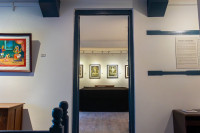
%20(1).jpg&w=200&height=120)

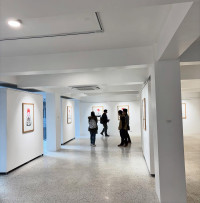
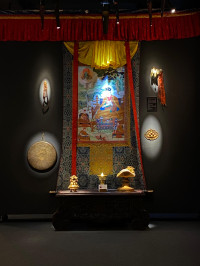
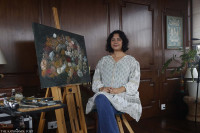


%20(1).jpg&w=300&height=200)

